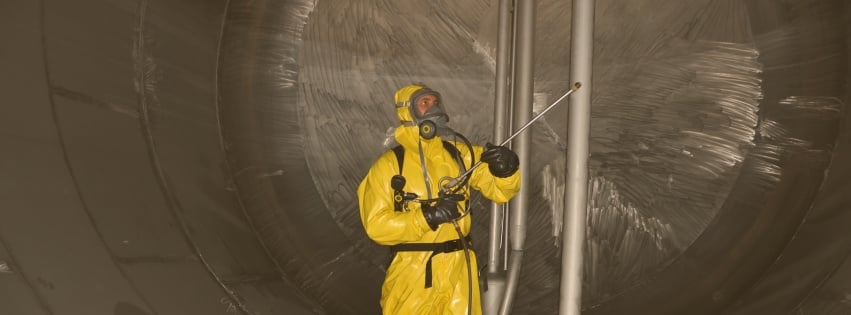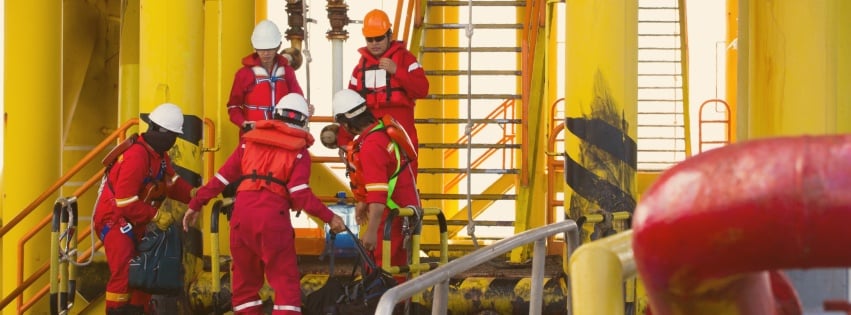
[av_icon_box position=’top’ icon_style=” boxed=” icon=’ue8df’ font=’entypo-fontello’ title=’Shutdown and turnaround management’ link=” linktarget=” linkelement=” font_color=’custom’ custom_title=’#000000′ custom_content=” color=’custom’ custom_bg=’#e4a93d’ custom_font=’#ffffff’ custom_border=” custom_class=” admin_preview_bg=”][/av_icon_box]
PART 2: THE IMPLEMENTATION PHASE, RESTART AND EVALUATION
[av_animated_numbers number=’3′ icon_select=’no’ icon=’ue84c’ font=’entypo-fontello’ font_size=” font_size_description=’30’ link=” linktarget=’no’ color=” custom_color=’#444444′ custom_class=” admin_preview_bg=”]
Implementation phase and restart
[/av_animated_numbers]
FROM SHUTDOWN TO INSPECTION
The implementation phase begins immediately after the equipment is turned off. In addition to performing the scheduled tasks, you will be faced with changes in scope, corrective actions and/or other unexpected problems. A detailed schedule (drawn up in the preparatory phase) serves as a guide when this needs to be adjusted daily. A few tips:
- Is a job finished earlier than expected? Transfer the available resources to tasks that are subject to delay.
- Identify the critical path items (sequence of interrelated tasks that directly affect the shutdown end date) and give them special attention.
- Indicate the status of each task to be performed.
- Make a daily overview of the KPIs that were developed in the preparatory phase (actual vs. budgeted costs, planned vs. actual working hours, overtime hours, overtime percentage,…) These are often displayed in graphs. KPIs are an excellent tool for optimizing the (temporary) workforce.
- Move each completed task to the validation phase for restart.
AFTER TESTING
The restart, the last step of the implementation phase, begins after testing by the operational staff, maintenance staff and designated inspectors. Transfer to the operational group will take place once the work has been completed, the punch-list items (list of points that still need to be adjusted, completed or improved) have been addressed and there are no longer any open factors that could influence the start-up.
Hand-off
The hand-off is the moment when the responsibility for a particular task passes from one person to another. It is also the time when the process is most vulnerable. This is where things often go wrong. Successfully managing hand-offs will lay the foundation for the efficiency and success of any process. Because they are difficult to optimize, they remain a major challenge. The presence of a technical support team ensures that sufficient support resources are available.
Ramp-up
After all equipment and machines are operational, the restart can begin. Ramp-up is the interval between start-up and normal operating conditions and capacities. It is an opportunity to observe the equipment that has been installed or modified and to make adjustments. Ramp-up is a critical phase and often disrupts operations.
The punchlist
A punch list is a list of tasks and items that must be checked, improved, or completed before the implementation phase can be considered complete. Creating and filling in an accurate punch list is essential for the smooth progress of a shutdown. All parties are involved, contractors, maintenance personnel and experts, in a final check. The shutdown can be considered a success if virtually all the points on the punch list can be ticked off.
SAFETY FIRST
Ensuring that all steps of a work plan are carried out, that safety equipment is worn and that LoTo (To) procedures are followed is essential during a shutdown.
LoToTo
LoToTo, also known as ‘Lock-Out, Tag-Out, Try-Out’, is a safety procedure used to ensure that dangerous machines are properly shut down and cannot be started. The difference with LoTo is in the Try-Out at the end. With a LoToTo, checking the security (the Try-Out) is also a part of the procedure, in order to offer greater certainty and safety. This can consist of the following steps:
- Drawing up a LoToTo manual that includes all procedures.
- Training all individuals involved.
- Carrying out the safety procedure.
- At the start of the work, all lock out/label out procedures must be followed and staff must be wearing all required personal protective equipment (PPE).
Useful downloadable information about LoTo(To):
Control of Hazardous Energy (Osha)
Download Logout – Tagout – Tryout handleiding (Unique Safety products)
Guide to Energy Isolation and LOTOTO (Reece)
Oplossing voor het onder controle houden van gevaarlijke energie (Nedelko)
Lockout/tagout Manual (ISU)
CPE AND PPE
The function of collective protective equipment (CPE) and personal protective equipment (PPE) is to reduce the risks to which employees and third parties are exposed to an acceptable level. This is protective equipment that is intended to protect the employee against one or more hazards that could endanger his health or safety at work, as well as all supplements or accessories intended for this purpose. CPE protects everyone in the area from the danger. That is a big difference with personal protective equipment, which merely has to protect an individual employee from harm. A zero-tolerance policy must be maintained throughout the shutdown period. If you have any questions, please contact the Regional Supervision Department of the Directorate-General for Well-being at Work: Afdeling van het regionaal toezicht van de Algemene Directie Toezicht op het Welzijn op het Werk
If you have any questions about the interpretation of the regulations, please contact the General Directorate for Humanisation of Labour: Algemene Directie Humanisering van de Arbeid.
More information and info brochures about PPE and CPE are available here:
- Belgische Federatie van leveranciers van PBM (Febelsafe – België) Febelsafe is the Belgian Federation of PPE suppliers. Febelsafe members can assist companies in the selection, use and maintenance of PPE. Febelsafe is also committed to safety and well-being in general. For example, the professional federation organises lectures, seminars and fairs on protective equipment and safety.
- The ‘European Safety Federation’ (ESF) is the European umbrella organisation of national PPE supplier associations. The federation plays the same role as the Belgian Febelsafe, but on a European level.
- Technisch en Wetenschappelijk Centrum voor de Belgische Textielnijverheid (Centexbel – België), or the Technical and Scientific Center for the Belgian Textile Industry (Centexbel – Belgium). Brochures and publications on PPE and textile properties are available in Dutch, French and English on the Centexbel website.
- The former National Action Committee for Safety and Hygiene in the Construction Industry (NAVB) was transformed into Constructiv and is the prevention institute for the construction sector. Reports on safety and health, such as a file on personal protective equipment in the construction sector, are available in Dutch and French on their website.
- CEN is the European Committee for Standardization, which also includes the Belgian Bureau for Standardization (NBN). CEN publishes a monthly list of the most recent standards. A search engine with which you can look up European standards is also available on the CEN website (in English).
- A list of the European standards for PPE is available on the website of the European Commission (EU). This website also contains other useful documents, such as a practical guide for working at height.
- NBN is het Belgische Bureau voor Normalisatie, or the Belgian Bureau for Standardization. Standards can be searched and ordered via the website. The NBN also has a library where standards can be consulted free of charge. More information is available in Dutch, English and French on the website of the NBN.

[av_animated_numbers number=’4′ icon_select=’no’ icon=’ue84c’ font=’entypo-fontello’ font_size=” font_size_description=’30’ link=” linktarget=’no’ color=” custom_color=’#444444′ custom_class=” admin_preview_bg=”]
Completion and evaluation
[/av_animated_numbers]
Organize an evaluation meeting to assess the entire shutdown. The agenda should include an evaluation of the EHS, KPIs, costs, timetable, punch lists, contractor management, shutdown and start-up phase. Make a clear overview of the lessons learned and critically review techniques, methods, processes and activities.
This is where you start looking for systems, processes, controls and tests that deliver the desired result with fewer problems and unforeseen complications. It is the starting point for the next shutdown. A few tips:
- Close or cancel purchase orders, work orders and service contracts.
- Log returned quantities into the maintenance management system for future planning purposes
- Apply the credited amount to the total failure costs in the affected area.
- Draw up a financial report detailing the costs associated with the failure, broken down by category – labour, materials, parts – so that actual numbers can be compared with the plan. This provides the opportunity to analyse costs horizontally and vertically throughout the system.
- Conduct a final audit to assess the performance of each element at each stage of the shutdown process.
- Prepare a final report summarizing each phase of the turnaround. This document should form the basis for updating the shutdown strategy and developing a business case for the next shutdown.
[av_animated_numbers number=’ONYX ONE’ icon_select=’no’ icon=’ue84c’ font=’entypo-fontello’ font_size=” font_size_description=’30’ link=” linktarget=’no’ color=’font-dark’ custom_color=’#444444′ custom_class=” admin_preview_bg=”]
Contractor Management System
[/av_animated_numbers]
Onyx One supports its customers before and during the shutdown process Our system:
- replaces the classroom briefings required in the run-up to the shutdown with online e-Learning modules.
- closely monitors who has not yet completed the preparation.
- ensures that all parties involved automatically receive the correct information.
- allows contractors to register their staff for the shutdown job.
- provides insight into which contractor can perform a particular risky task.
- maintains an overview through interactive checklists.
- ensures a thorough follow-up and keeps track of important information for the next shutdown.
Source:
Oh, J. Seveso II-richtlijn: voor overheid en bedrijven. Arbeidsomstandigheden.
Inventarisatie verlaging van de faseringsfactor. Arbeidsveiligheidsrapport. Comprimo,
Wiersma, T. Safety Performance Indicatoren. Doelfinancieringsvoorstel
Responsible Care Progress Report, DSM,
Hale, A.R.; Heming, B.H.J.; Smit, K.; Rodenburg, F.G.Th.; Van Leeuwen. N.D. Evaluating
Safety in the Management of Maintenance Activities in the Chemical Process Industry.
PMI Standards Committee: a Guide to the Project Management Body of Knowledge.
Oliver, R: organising the Plan for Turnarounds. Petroleum Technology Quarterly. USA.
Bos, M. H: The Shutdown Manager’s Pre-Shutdown Checklist.
Dickey, M. L. and Velasquez-Griffith, P.: ^ractices for Successful Turnarounds, Independent Project Analysis,